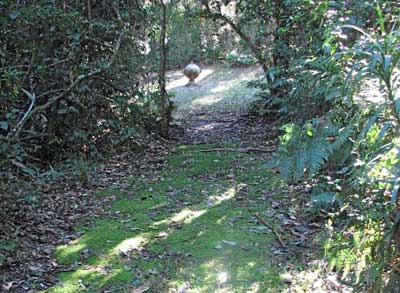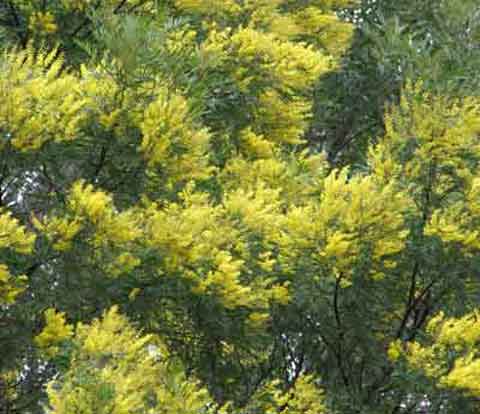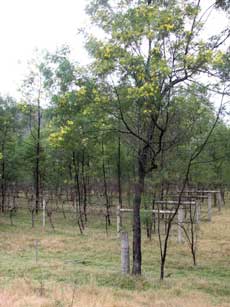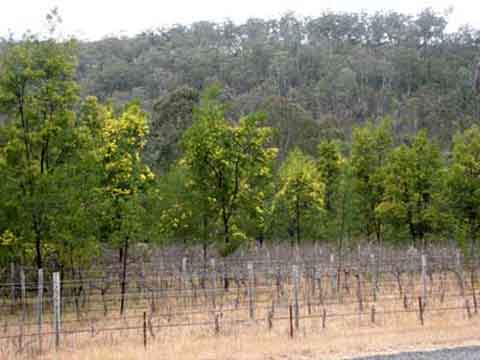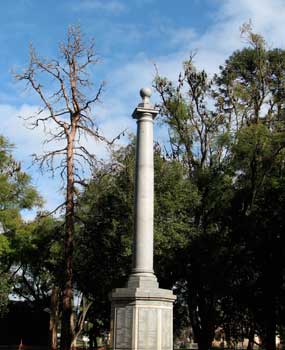 If you became homeless because your house was being demolished, obviously you’d have to find a new home to live in. It’s no different for other animals; we all need shelter, a home, habitat.
If you became homeless because your house was being demolished, obviously you’d have to find a new home to live in. It’s no different for other animals; we all need shelter, a home, habitat.
However, I suppose we wouldn’t be allowed to choose the amenities block or the bandstand in a public park, let alone bring all our relatives. Similarly, there is much ado when a whole colony of wild creatures takes up residence in civic gardens or parks. Grey-headed Flying-foxes are a common ‘nuisance’ in many town and city parks as land clearing proceeds for development such as mining or housing, and their natural habitat is disturbed or lost. Communities are then divided with debates about how to make them move on before they defoliate all the long-established and cherished trees in a park like this one.
Sydney’s Botanic Gardens has the same problem. Bat droppings, bat screechings and bare trees are not the most inviting ambience for picnickers, walkers — or Anzac Day ceremonies.
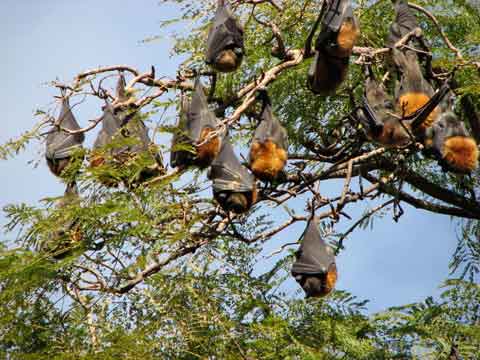
But they are merely the victims, like many of us, of shortsighted ‘planning’. In fact, these Grey-headed Flying-foxes (sometimes called Grey-headed Fruit-bats) are listed as a vulnerable species.
I took the chance to observe them at a stop at this park. After all, it’s pretty amazing that bats are the only mammals capable of sustained flight.
They spend the day in large camps and head out to feed at night, using sight and smell to find their preferred foods, the blossom and nectar of eucalypts and native fruits and lillipillies.
From introduced trees like jacarandas and firs they were hanging like thousands of leather lanterns with bright furry tops — each upside-down, and by the claws of one forelimb, daredevil style.
They can see quite well in daytime so that must be why they tuck their heads in. Many seem to have trouble getting comfy – they screeched and chattered and wriggled, stretched and flapped their amazing wings, which can exceed a metre in span, before rewrapping themselves in their slinky Batman blankets.
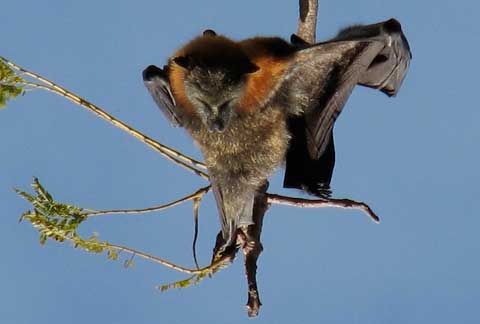
These Flying-foxes, with their foxfire collars, do have faces like foxes, or dogs, as the reversed photo of this restless one shows. They are not at all ugly, and certainly fascinating.
I don’t think I’d want them as close neighbours, but then I’m increasing rather than reducing habitat here, so there’d be room for us all.
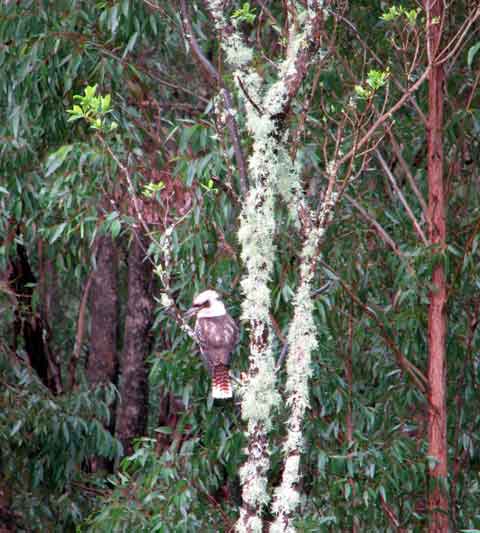
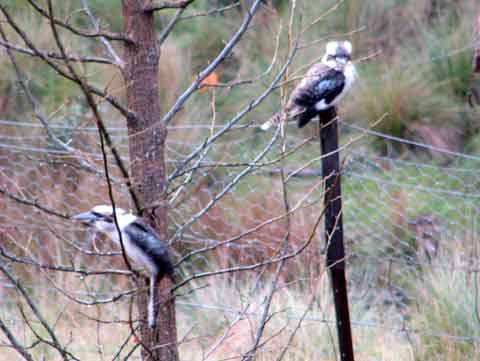

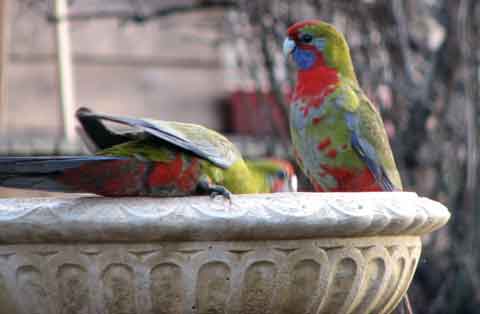
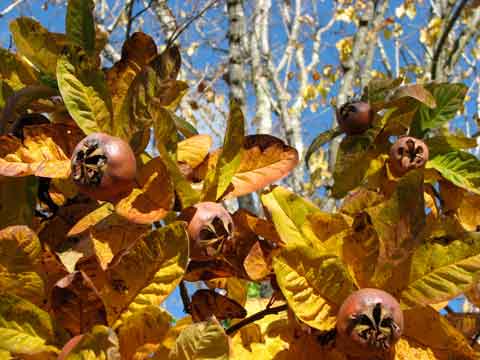

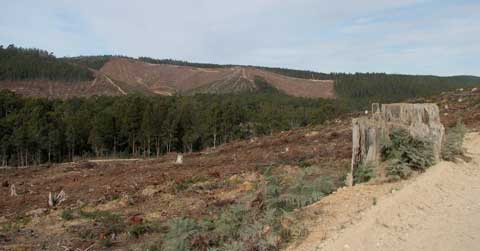

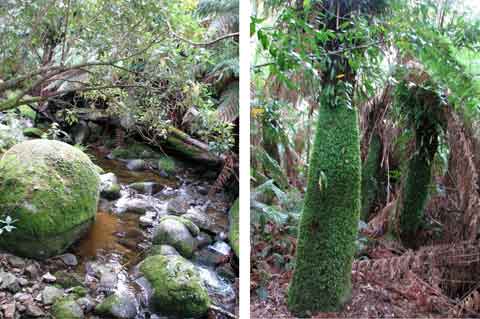
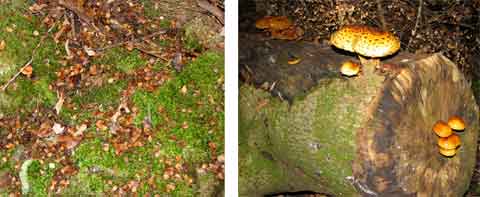
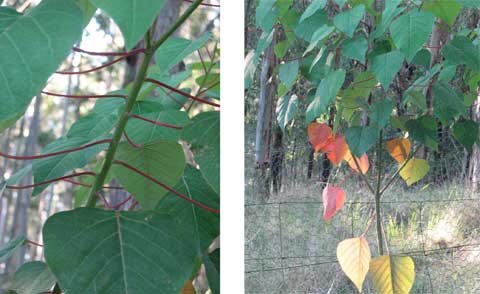 It’s Autumn, and my yard is being coloured– by more than autumn leaves.
It’s Autumn, and my yard is being coloured– by more than autumn leaves.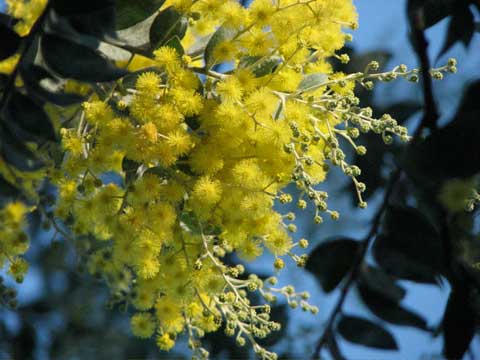 The first bunches of wattle blossom have burst out of their tightly fisted buds — small explosions of powdery gold, honey-scented. I grew lots of these from seeds that fell from a tree in my Aunty Mary’s front yard in Sydney; we didn’t know what sort it was, but perhaps it’s a Queensland Silver Wattle (Acacia podalyriifolia)?
The first bunches of wattle blossom have burst out of their tightly fisted buds — small explosions of powdery gold, honey-scented. I grew lots of these from seeds that fell from a tree in my Aunty Mary’s front yard in Sydney; we didn’t know what sort it was, but perhaps it’s a Queensland Silver Wattle (Acacia podalyriifolia)?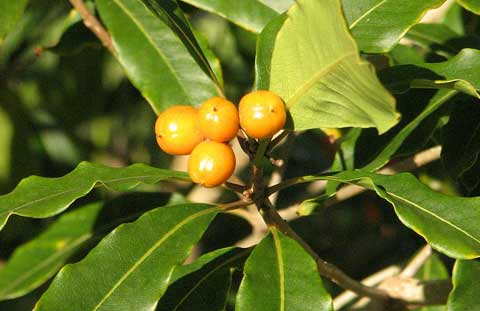 The bird-sown gift of a Pittosporum undulatum tree, also indigenous, has fruited its mini cumquat bunches for the first time. How did I miss the flowers? The bird didn’t plant it in the position I’d have chosen, but this has soared to such a height so quickly that it clearly found the perfect spot for the tree — if not for me!
The bird-sown gift of a Pittosporum undulatum tree, also indigenous, has fruited its mini cumquat bunches for the first time. How did I miss the flowers? The bird didn’t plant it in the position I’d have chosen, but this has soared to such a height so quickly that it clearly found the perfect spot for the tree — if not for me!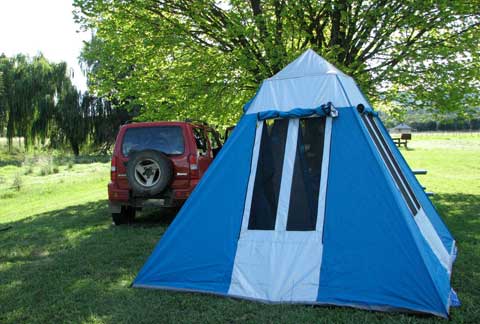
 They seemed to be the only ones on the tree; luckily I refrained from picking one long enough to realise they were not seeds. Like Indian clubs, these smooth creations were hanging from a criss-cross of spider webs. I could just see the spider’s legs protruding from its dry leaf shelter (circled).
They seemed to be the only ones on the tree; luckily I refrained from picking one long enough to realise they were not seeds. Like Indian clubs, these smooth creations were hanging from a criss-cross of spider webs. I could just see the spider’s legs protruding from its dry leaf shelter (circled).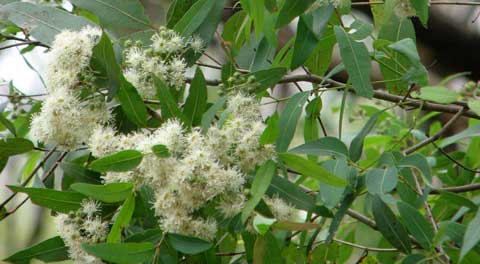 I don’t plant annuals, so my garden is never the riot of colour that others manage. I rely on bushes and bulbs to surprise me with blossoms.
I don’t plant annuals, so my garden is never the riot of colour that others manage. I rely on bushes and bulbs to surprise me with blossoms.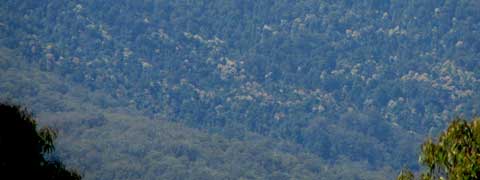 I am assuming this is what caused the splashes of cream I could see a week earlier, way off on the far slopes of the higher ridges opposite. Too far away for detail, even with binoculars.
I am assuming this is what caused the splashes of cream I could see a week earlier, way off on the far slopes of the higher ridges opposite. Too far away for detail, even with binoculars.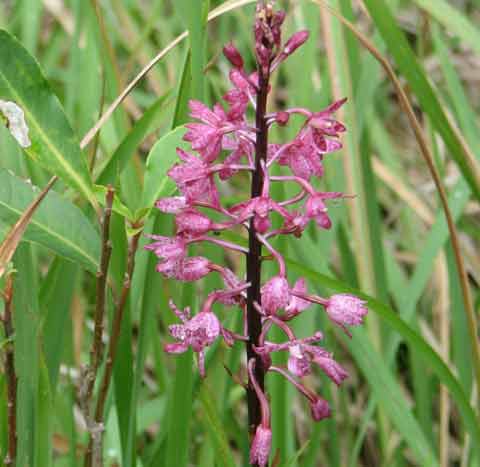 But in the immediate bush, I have no trouble spotting the highlights of summer wildflowers here, the Hyacinth Orchids, Dipodium punctatum. Apparently these orchids live on subterranean fungi which form on the decaying matter of the forest floor.
But in the immediate bush, I have no trouble spotting the highlights of summer wildflowers here, the Hyacinth Orchids, Dipodium punctatum. Apparently these orchids live on subterranean fungi which form on the decaying matter of the forest floor.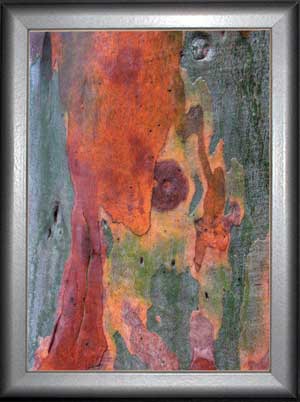 The significance of ultra-abstract art often eludes me; I might appreciate it as design and colour, but it doesn’t speak to me. I don’t warm to it, relate to it, as I can to the merely abstracted, stylised, simplified, where the origin is vaguely discernible. In the latter the artist’s treatment of it stimulates my imagination more than straight realism would.
The significance of ultra-abstract art often eludes me; I might appreciate it as design and colour, but it doesn’t speak to me. I don’t warm to it, relate to it, as I can to the merely abstracted, stylised, simplified, where the origin is vaguely discernible. In the latter the artist’s treatment of it stimulates my imagination more than straight realism would.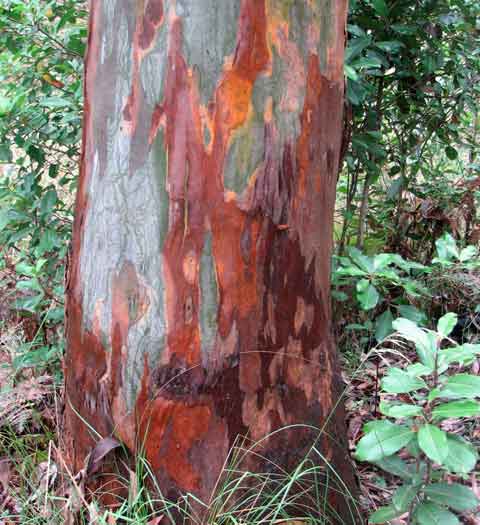 The cabin might be full, but I live in the midst of a forest that can dazzle me with temporary exhibitions of works of art like this one. The paint was fresh and bright after a spell of rain; a week later the colours will dull and fade, or flake off.
The cabin might be full, but I live in the midst of a forest that can dazzle me with temporary exhibitions of works of art like this one. The paint was fresh and bright after a spell of rain; a week later the colours will dull and fade, or flake off.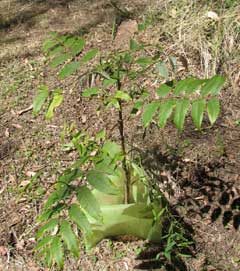 My little Red Cedar (Toona australis) trees are putting forth new leaves. These are of bronzed burgundy red, although the trees are not named for that, but for the rich red of the timber when cut.
My little Red Cedar (Toona australis) trees are putting forth new leaves. These are of bronzed burgundy red, although the trees are not named for that, but for the rich red of the timber when cut.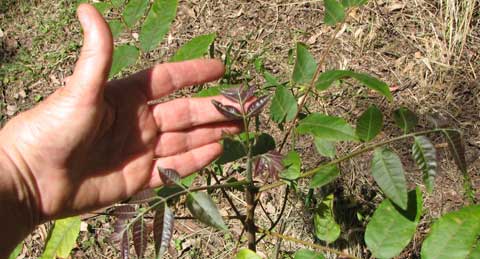
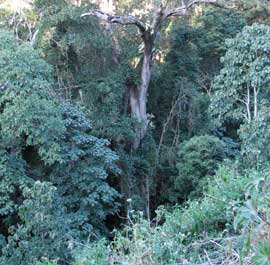 Drivng back from the Gloucester district a few weeks ago, I passed above the very steep and narrow, very special gully near Dungog where a remnant rainforest of giant trees like figs and stinging trees and white cedars stand tall and proud amidst a dense jungle of vines competing for the light.
Drivng back from the Gloucester district a few weeks ago, I passed above the very steep and narrow, very special gully near Dungog where a remnant rainforest of giant trees like figs and stinging trees and white cedars stand tall and proud amidst a dense jungle of vines competing for the light.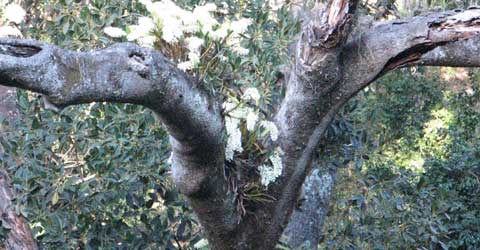 Thanks to the magic of my zoom lens, I could be sure that they were King Orchids (Dendrobium speciosum, var. hillii) Hundreds of feet up, several fat clumps of them had colonised in forks of the trunk, clinging on with their fleshy fingers as they climbed along the broad branches. A staghorn shared their treehouse.
Thanks to the magic of my zoom lens, I could be sure that they were King Orchids (Dendrobium speciosum, var. hillii) Hundreds of feet up, several fat clumps of them had colonised in forks of the trunk, clinging on with their fleshy fingers as they climbed along the broad branches. A staghorn shared their treehouse.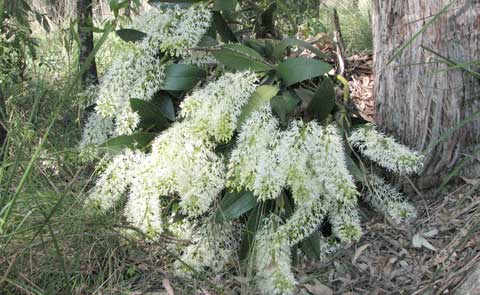 At the time, my orphaned clumps of the same orchid had been still in bud, my place being so much higher in altitude.
At the time, my orphaned clumps of the same orchid had been still in bud, my place being so much higher in altitude.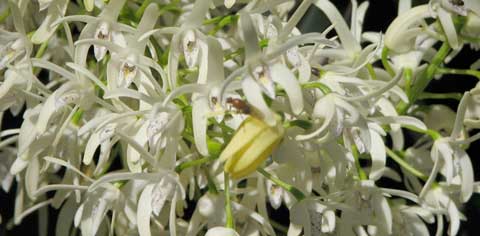
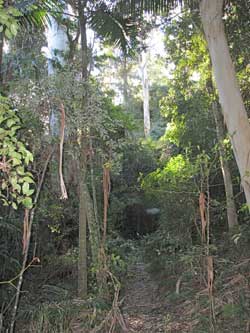 They tempt you to walk into the wild side, but with safety, and to experience the greatly varied vegetation of the surrounding bush.
They tempt you to walk into the wild side, but with safety, and to experience the greatly varied vegetation of the surrounding bush. Robert has chosen the paths to take you through hillside forests and gully jungles, past luminous blue gums and thriving cabbage tree palms, the oldest, wartiest paperbark tree I have ever seen…
Robert has chosen the paths to take you through hillside forests and gully jungles, past luminous blue gums and thriving cabbage tree palms, the oldest, wartiest paperbark tree I have ever seen…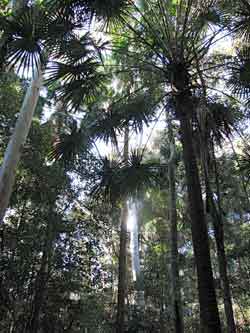 …and battle-scarred eucalypts so tall I can hardly see their tops.
…and battle-scarred eucalypts so tall I can hardly see their tops.
